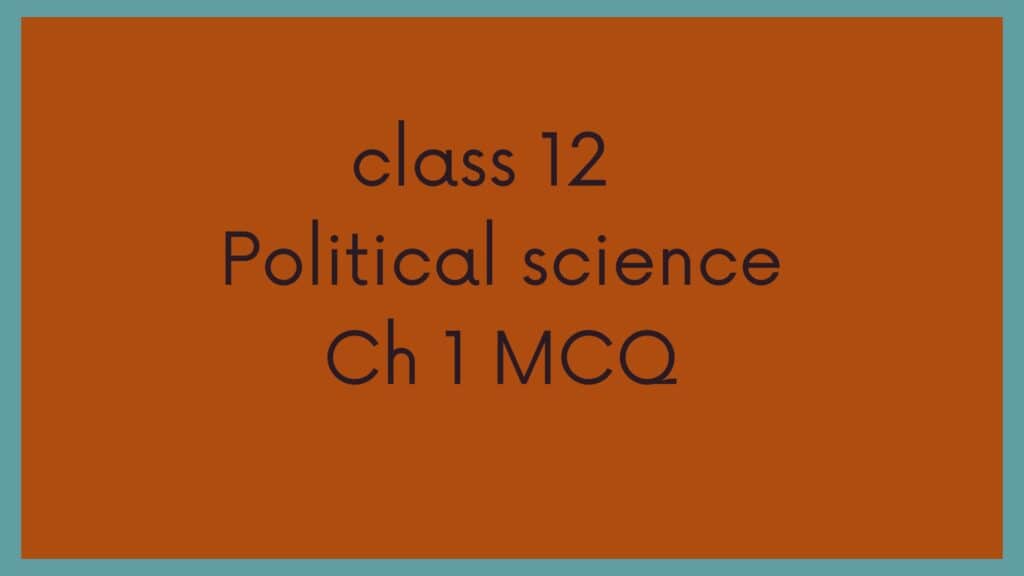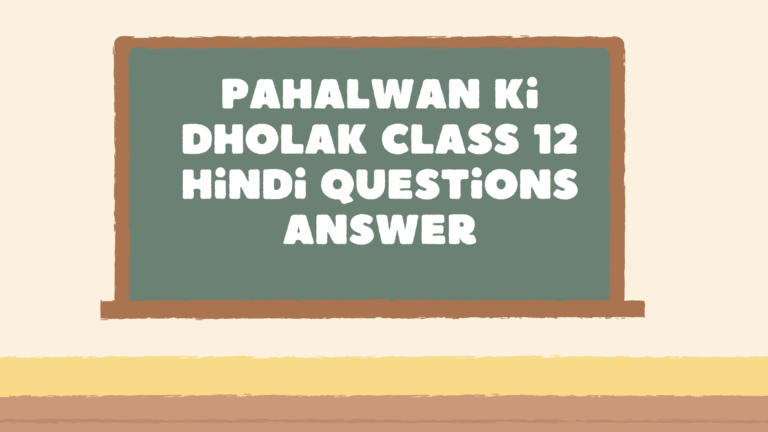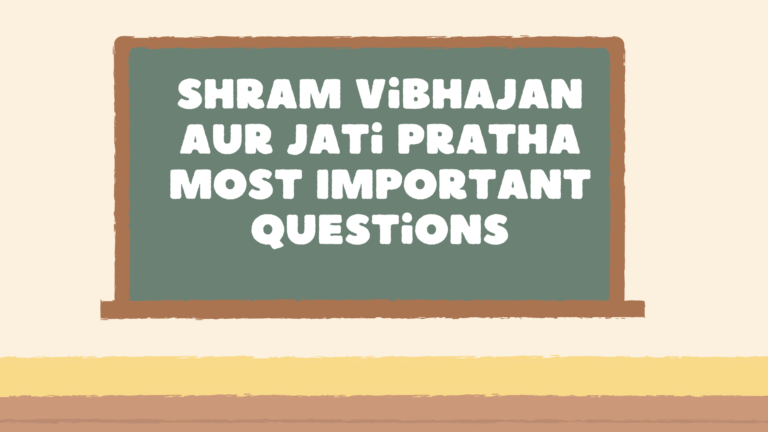Class 12 Political Science Chapter 1 MCQ | The End of Bipolarity Important MCQ
This article will help you with Class 12 Political Science Chapter 1 MCQ. The End of Bipolarity Important MCQs are very helpful for your exam preparation as per the new CBSE patterns.

Political Science – Chapter 1: The End of Bipolarity
Class 12 Political Science Chapter 1 MCQ
Q1. In which year did the Berlin Wall fall?
a) 1985
b) 1989
c) 1991
d) 1979
Answer: b) 1989
Q2. When did the Soviet Union disintegrate?
a) 1988
b) 1990
c) 1991
d) 1995
Answer: c) 1991
Q3. Who introduced the policies of Glasnost and Perestroika?
a) Stalin
b) Mikhail Gorbachev
c) Lenin
d) Boris Yeltsin
Answer: b) Mikhail Gorbachev
Q4. What type of alliance was the Warsaw Pact?
a) Economic
b) Military
c) Cultural
d) Religious
Answer: b) Military
Q5. The political system of the USSR was based on which ideology?
a) Capitalism
b) Socialism
c) Liberalism
d) Nationalism
Answer: b) Socialism
Q6. How many republics made up the USSR?
a) 10
b) 12
c) 15
d) 20
Answer: c) 15
Q7. Which country was recognized as the successor of the USSR?
a) Belarus
b) Russia
c) Ukraine
d) Kazakhstan
Answer: b) Russia
Q8. What was “Shock Therapy” related to?
a) Agricultural reforms
b) Transition from communism to capitalism
c) Education policy
d) Science and technology
Answer: b) Transition from communism to capitalism
Q9. Which Baltic state was the first to demand independence from the USSR?
a) Latvia
b) Lithuania
c) Estonia
d) Ukraine
Answer: b) Lithuania
Q10. In 1979, the Soviet Union invaded which country?
a) Vietnam
b) Afghanistan
c) Poland
d) Germany
Answer: b) Afghanistan
Q11. The end of the Cold War marked the rise of which power?
a) China
b) USA
c) Japan
d) European Union
Answer: b) USA
Q12. Which country was reunified after the fall of the Berlin Wall?
a) Korea
b) Germany
c) Vietnam
d) Poland
Answer: b) Germany
Q13. Which of the following was NOT a reason for the disintegration of the USSR?
a) Political stagnation
b) Economic weaknesses
c) Military defeat in World War II
d) Nationalist movements
Answer: c) Military defeat in World War II
Q14. What does Glasnost mean?
a) Restructuring
b) Openness
c) Freedom
d) Democracy
Answer: b) Openness
Q15. What does Perestroika mean?
a) Reconstruction / Restructuring
b) Freedom
c) Transparency
d) Democracy
Answer: a) Reconstruction / Restructuring
Q16. Who became the first President of Russia after the USSR’s collapse?
a) Vladimir Putin
b) Boris Yeltsin
c) Mikhail Gorbachev
d) Leonid Brezhnev
Answer: b) Boris Yeltsin
Q17. Which alliance disintegrated after the Cold War?
a) NATO
b) Warsaw Pact
c) ASEAN
d) OPEC
Answer: b) Warsaw Pact
Q18. The Commonwealth of Independent States (CIS) was formed by—
a) Baltic States
b) Russia and former Soviet republics
c) NATO countries
d) European Union
Answer: b) Russia and former Soviet republics
Q19. The Soviet model emphasized—
a) Free market economy
b) State control of economy
c) Private ownership
d) Liberal democracy
Answer: b) State control of economy
Q20. Which superpower became dominant after 1991?
a) Russia
b) USA
c) China
d) UK
Answer: b) USA
Q21. Which of the following was a negative consequence of Shock Therapy?
a) Rise in poverty
b) Economic inequality
c) Decline in industrial output
d) All of the above
Answer: d) All of the above
Q22. Which Soviet policy allowed greater freedom of expression?
a) Perestroika
b) Glasnost
c) Privatisation
d) Communism
Answer: b) Glasnost
Q23. Who described the collapse of the USSR as the “greatest geopolitical catastrophe”?
a) Gorbachev
b) Yeltsin
c) Putin
d) Brezhnev
Answer: c) Putin
Q24. Which international organization replaced GATT in 1995?
a) IMF
b) WTO
c) UNCTAD
d) EU
Answer: b) WTO
Q25. Which of the following republics of the USSR had nuclear weapons?
a) Ukraine
b) Belarus
c) Kazakhstan
d) All of the above
Answer: d) All of the above
Q26. NATO was formed in which year?
a) 1945
b) 1949
c) 1955
d) 1962
Answer: b) 1949
Q27. The Soviet economy was highly dependent on—
a) Agriculture
b) Oil and natural resources
c) Tourism
d) Foreign investment
Answer: b) Oil and natural resources
Q28. The Marshall Plan was associated with—
a) Soviet reconstruction
b) European reconstruction with US aid
c) Asian development
d) African nations’ independence
Answer: b) European reconstruction with US aid
Q29. Who was the US President at the time of the USSR’s collapse?
a) Ronald Reagan
b) George H.W. Bush
c) Bill Clinton
d) Jimmy Carter
Answer: b) George H.W. Bush
Q30. Which year is generally regarded as the end of the Cold War?
a) 1989
b) 1990
c) 1991
d) 1995
Answer: c) 1991
The End of Bipolarity Important MCQ – Assertion–Reason Questions
Q1.
Assertion (A): The fall of the Berlin Wall symbolized the end of the Cold War.
Reason (R): It led to the reunification of Germany.
Answer: Both A and R are true, and R correctly explains A.
Q2.
Assertion (A): Gorbachev’s reforms weakened the Soviet Union.
Reason (R): Glasnost and Perestroika exposed problems instead of solving them.
Answer: Both A and R are true, and R explains A.
Q3.
Assertion (A): The USSR was economically stronger than the USA.
Reason (R): The Soviet model focused on heavy industrialization.
Answer: A is false, R is true.
Q4.
Assertion (A): Shock Therapy benefited all citizens equally.
Reason (R): Privatisation created economic equality.
Answer: Both A and R are false.
Q5.
Assertion (A): The disintegration of the USSR created new independent nations.
Reason (R): Nationalist movements played a major role in its collapse.
Answer: Both A and R are true, and R explains A.
Q6.
Assertion (A): NATO was dissolved after the Cold War.
Reason (R): Military alliances were no longer necessary.
Answer: Both A and R are false.
Q7.
Assertion (A): The Soviet economy was highly centralized.
Reason (R): The state controlled production and distribution.
Answer: Both A and R are true, and R explains A.
Q8.
Assertion (A): Russia emerged as the sole successor of the USSR.
Reason (R): Russia inherited the USSR’s nuclear arsenal and UN Security Council seat.
Answer: Both A and R are true, and R explains A.
Q9.
Assertion (A): The Cold War ended peacefully.
Reason (R): There was no large-scale war between the US and USSR during its end.
Answer: Both A and R are true, and R explains A.
Q10.
Assertion (A): The Soviet model was based on liberal democracy.
Reason (R): It emphasized multi-party elections and free markets.
Answer: Both A and R are false.
The End of Bipolarity: Important MCQ – Statement-Based Questions
Q1. Consider the following statements:
i) The USSR collapsed in 1991.
ii) Russia became the sole successor state.
iii) Germany remained divided even after 1989.
Which are correct?
a) i and ii
b) ii and iii
c) i and iii
d) All three
Answer: a) i and ii
Q2. Consider the following statements about Shock Therapy:
i) It created economic equality.
ii) It increased poverty and unemployment.
iii) It caused the collapse of industries.
Which are correct?
a) i and ii
b) ii and iii
c) i and iii
d) All three
Answer: b) ii and iii
Q3. Consider the following:
i) NATO was formed in 1949.
ii) Warsaw Pact was formed in 1955.
iii) Warsaw Pact was led by the USA.
Which are correct?
a) i and ii
b) ii and iii
c) i and iii
d) All three
Answer: a) i and ii
Q4. Consider the following:
i) Glasnost means openness.
ii) Perestroika means restructuring.
iii) Both were introduced by Gorbachev.
Which are correct?
a) i and ii
b) ii and iii
c) i and iii
d) All three
Answer: d) All three
Q5. Consider the following:
i) The Cold War ended with violence.
ii) The Soviet Union disintegrated peacefully.
iii) US emerged as the sole superpower.
Which are correct?
a) i and ii
b) ii and iii
c) i and iii
d) All three
Answer: b) ii and iii
Class 12 Hindi Chapter 2 Question Answer | पतंग Important Question Answer






2 Comments